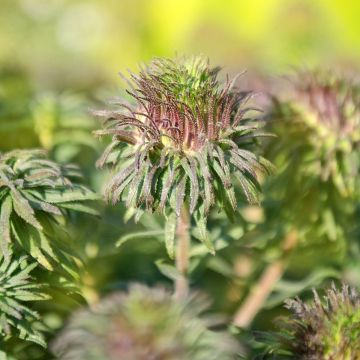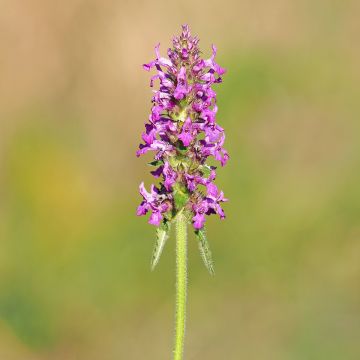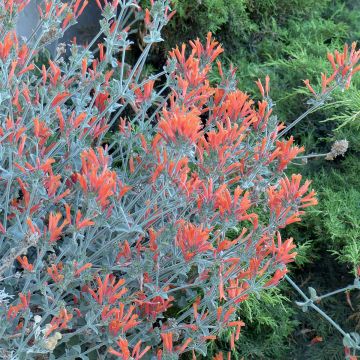

Aster Pink Star


Aster Pink Star
Aster Pink Star
Aster pringlei x ericoïdes Pink Star
Pringle's Aster, Heath Aster
Did not take.
Marie, 28/12/2021
This item cannot be shipped to the selected country
Delivery charge from €5.90
More information
Schedule delivery date,
and select date in basket
This plant carries a 12 months recovery warranty
More information
We guarantee the quality of our plants for a full growing cycle, and will replace at our expense any plant that fails to recover under normal climatic and planting conditions.
From €5.90 for pickup delivery and €6.90 for home delivery
Express home delivery from €8.90.
Does this plant fit my garden?
Set up your Plantfit profile →
Description
The Pink Star hybrid Aster, aka Aster ericoides Pink Star, is a dense perennial that blooms from September to early November in a cloud of pinkish-purple flowers. Small, thin, green lanceolate leaves cover the slightly stiff and branching stems. This plant maintains a compact bushy shape and does not sucker. It is undemanding, not very susceptible to diseases, and thrives in well-drained soil, preferring a sunny position and tolerant of drought.
The Pink Star hybrid Aster belongs to the Asteraceae family and is a horticultural creation resulting from cross breeding between Aster ericoides and Aster Pringlei. It combines qualities such as a bushy habit, slender and sturdy stems, fine linear foliage, and extraordinary floriferousness. It also has perfect disease resistance and excellent adaptability to difficult conditions. This herbaceous perennial forms a flowering clump of 1m (3ft) in height and 30 cm (12in) in spread. Its growth rate is quite rapid. The very generous flowering occurs from September until the first days of November. The inflorescence is a semi-double capitule with peripheral ligulate flowers that are pinkish-purple and very delicate. The central flowers (the heart) are bright yellow, turning purple. The heads measure about 2 cm (1in) in diameter and are grouped in short corymbs, numbering 2 to 6. This aster is a deciduous perennial with slightly hairy stems. The basal leaves are slightly pubescent, entire, oblong, lanceolate, and medium green. The cauline leaves are linear, sessile (without petioles), and acute.
It is impossible to imagine our gardens without aster beds or borders. This variety is particularly undemanding, yet highly ornamental. It is a boon for wild gardens, large dry slopes, and the unfrequented corners of the garden. It pairs well with all other plants in the flowerbeds, such as Salvia microphylla, all 'sunflowers' such as the 'Lemon Queen' helianthus, heleniums, goldenrods, and large rudbeckias. Try planting alongside Aster Pink Star, Aster turbinellus, Sedum 'Purple Emperor', and Penstemon 'Mother of pearl' for a combination of colours, foliage, and textures that is delightful from summer to autumn. Group 3 or 5 Pink Star Asters at the back of the bed to create a vibrant, ethereal mass in the autumn light. 'Pink Star' is also an excellent cut flower, much appreciated for country-style bouquets.
Report an error about the product description
Aster Pink Star in pictures


Flowering
Foliage
Plant habit
Botanical data
Aster
pringlei x ericoïdes
Pink Star
Asteraceae
Pringle's Aster, Heath Aster
Cultivar or hybrid
Other Asters
Planting and care
Plant the Pink Star hybrid Aster in autumn or spring in regular, light, well-worked, sandy or loamy soil, moist to dry, perfectly drained. Heavy and wet soils will shorten its lifespan. It appreciates full sun. It is not necessary to stake the plant but avoid strong winds that would flatten the clumps. Avoid moving once established as it does not like change. In a bed, maintain a spacing of at least 50 cm (20in) around the plant. Undemanding and disease resistant, it likes a sunny site and tolerates drought very well, which does not compromise its flowering. Cut back the dry stems in autumn/winter. To propagate, simply take pieces of rooted stems from the edge of the stump in early spring. Its longevity is great, meaning this plant does not need to be divided every few years.
Planting period
Intended location
Care
-
, onOrder confirmed
Reply from on Promesse de fleurs
Summer flowering perennials
Haven't found what you were looking for?
Hardiness is the lowest winter temperature a plant can endure without suffering serious damage or even dying. However, hardiness is affected by location (a sheltered area, such as a patio), protection (winter cover) and soil type (hardiness is improved by well-drained soil).

Photo Sharing Terms & Conditions
In order to encourage gardeners to interact and share their experiences, Promesse de fleurs offers various media enabling content to be uploaded onto its Site - in particular via the ‘Photo sharing’ module.
The User agrees to refrain from:
- Posting any content that is illegal, prejudicial, insulting, racist, inciteful to hatred, revisionist, contrary to public decency, that infringes on privacy or on the privacy rights of third parties, in particular the publicity rights of persons and goods, intellectual property rights, or the right to privacy.
- Submitting content on behalf of a third party;
- Impersonate the identity of a third party and/or publish any personal information about a third party;
In general, the User undertakes to refrain from any unethical behaviour.
All Content (in particular text, comments, files, images, photos, videos, creative works, etc.), which may be subject to property or intellectual property rights, image or other private rights, shall remain the property of the User, subject to the limited rights granted by the terms of the licence granted by Promesse de fleurs as stated below. Users are at liberty to publish or not to publish such Content on the Site, notably via the ‘Photo Sharing’ facility, and accept that this Content shall be made public and freely accessible, notably on the Internet.
Users further acknowledge, undertake to have ,and guarantee that they hold all necessary rights and permissions to publish such material on the Site, in particular with regard to the legislation in force pertaining to any privacy, property, intellectual property, image, or contractual rights, or rights of any other nature. By publishing such Content on the Site, Users acknowledge accepting full liability as publishers of the Content within the meaning of the law, and grant Promesse de fleurs, free of charge, an inclusive, worldwide licence for the said Content for the entire duration of its publication, including all reproduction, representation, up/downloading, displaying, performing, transmission, and storage rights.
Users also grant permission for their name to be linked to the Content and accept that this link may not always be made available.
By engaging in posting material, Users consent to their Content becoming automatically accessible on the Internet, in particular on other sites and/or blogs and/or web pages of the Promesse de fleurs site, including in particular social pages and the Promesse de fleurs catalogue.
Users may secure the removal of entrusted content free of charge by issuing a simple request via our contact form.
The flowering period indicated on our website applies to countries and regions located in USDA zone 8 (France, the United Kingdom, Ireland, the Netherlands, etc.)
It will vary according to where you live:
- In zones 9 to 10 (Italy, Spain, Greece, etc.), flowering will occur about 2 to 4 weeks earlier.
- In zones 6 to 7 (Germany, Poland, Slovenia, and lower mountainous regions), flowering will be delayed by 2 to 3 weeks.
- In zone 5 (Central Europe, Scandinavia), blooming will be delayed by 3 to 5 weeks.
In temperate climates, pruning of spring-flowering shrubs (forsythia, spireas, etc.) should be done just after flowering.
Pruning of summer-flowering shrubs (Indian Lilac, Perovskia, etc.) can be done in winter or spring.
In cold regions as well as with frost-sensitive plants, avoid pruning too early when severe frosts may still occur.
The planting period indicated on our website applies to countries and regions located in USDA zone 8 (France, United Kingdom, Ireland, Netherlands).
It will vary according to where you live:
- In Mediterranean zones (Marseille, Madrid, Milan, etc.), autumn and winter are the best planting periods.
- In continental zones (Strasbourg, Munich, Vienna, etc.), delay planting by 2 to 3 weeks in spring and bring it forward by 2 to 4 weeks in autumn.
- In mountainous regions (the Alps, Pyrenees, Carpathians, etc.), it is best to plant in late spring (May-June) or late summer (August-September).
The harvesting period indicated on our website applies to countries and regions in USDA zone 8 (France, England, Ireland, the Netherlands).
In colder areas (Scandinavia, Poland, Austria...) fruit and vegetable harvests are likely to be delayed by 3-4 weeks.
In warmer areas (Italy, Spain, Greece, etc.), harvesting will probably take place earlier, depending on weather conditions.
The sowing periods indicated on our website apply to countries and regions within USDA Zone 8 (France, UK, Ireland, Netherlands).
In colder areas (Scandinavia, Poland, Austria...), delay any outdoor sowing by 3-4 weeks, or sow under glass.
In warmer climes (Italy, Spain, Greece, etc.), bring outdoor sowing forward by a few weeks.






















































